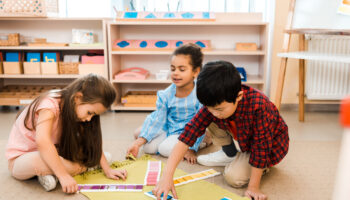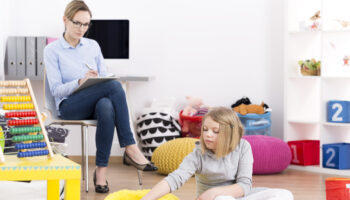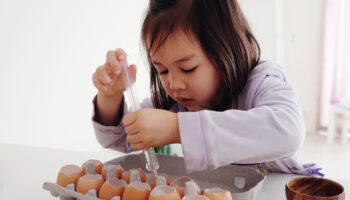By Regina Wright
Close your eyes. Now use four of your five senses. Without opening your eyes, listen to the sounds of spring. What do you hear? Listen as the birds sing. Feel the heat as the sun shines brightly beneath the wind. Now reach out with your hands and feel the textures that are around you. You can almost taste the scent of the plants and flowers that bloom surrounding your feet. Now use your fifth sense to slowly open your eyes. Now you thought you were outside in a garden. What do you see? A classroom filled with nature. That’s exactly what I see.R
The neutral colors make for a realistic view. I am immersed in the beauty and simplicity of life. It gives me a calmness like no other. It’s like having an out of body experience. You know where you are; you’re just not sure your mind and body are in the same place. Where do you go from here? Your potential is limitless.
Not only do we strive in the beauty of it all, but children do also! The natural light paves the way to success beyond belief. Classrooms that include the seven principles of design enhance children’s learning. How do we know? We use the ROSIE as our program observation tool. What is the ROSIE?
ROSIE A groundbreaking tool that assesses classrooms in a whole new way!
An inspiring environment is essential for helping young children learn. The Rating Observation Scale for Inspiring Environments (ROSIE) is an observation rating scale that challenges teachers to examine classrooms in a totally new way: with an eye for what is aesthetically beautiful and inspiring.
Looking through an aesthetic lens of nature, color, furnishings, textures, displays, lighting, and focal points, educators will learn to determine a classroom’s level of aesthetic beauty. ROSIE then provides images and examples to assist in turning learning spaces into inspirational environments in which children can grow and learn.
Seven principles of design are included in the ROSIE scale. Let’s look at each of them.
Principle 1: nature inspires beauty- Did you know that nature can touch all our senses? At times when we can’t visit our favorite natural spaces, we can bring pieces of nature into the classroom and experience some of its benefits. Imagine a classroom filled with sights, sounds, tastes, and textures. How would that look to you? I see natural light, flowers, plants, rocks, and seashells. I hear the soft sounds of birds chirping, water flowing and wind blowing. Natural smells such as lavender, grass and wood are pleasant and help connect us to nature. Leaves, tree bark, stones, sand, and pinecones offer opportunities for children to feel various textures.
Principle 2: color generates interest- Color is also stimulating and can be used to promote calmness in the environment. Educators used to believe that the more color the better and we often chose to decorate classroom with primary colors throughout play spaces. We now know that color can overstimulate and create chaos. Neutral colors are muted shades that appear to lack color but have underlying cues that change with different lighting. Examples of neutral colors include beige, taupe, gray, white, black, brown, and cream. These colors help maintain balance and can offer a sense of peace and tranquility in your classroom.
Principle 3: furnishings define space- When furnishing your classroom, choosing the right sizes and shapes helps to support play. It also helps to enhance the areas and centers children enjoy such as dramatic play, art, blocks, science, and library.
Principle 4: texture adds depth and helps stimulate the tactile system in the process- Having water and/or sand tables, finger paints, stuffed animals, play dough, clay, slime and putty support children’s learning through touch and texture and is also a great opportunity to strengthen fine motor skills.
Principle 5: displays enhance environment- By organizing toys and materials and displaying children’s work, children feel a sense of value, ownership, and belonging. Family portraits help children feels secure as well. Labeling not only helps children keep things arranged and in order; it can also help children with pre-reading skills.
Principle 6: elements heighten ambience- Multiple sources of natural and artificial light sources help open space and illuminate the classroom environment. Lights are attractive and appealing to help children remain focused.
Principle 7: focal points attract attention- When entering the classroom focal points are attractive, inviting and help motivate children. Some of the focal points that stood out to me when observing classrooms are morning meeting or group spaces, transition space, and teacher workstation.
As you prepare to determine your ROSIE level of growth, it is important to become an objective observer. Use an aesthetic perspective when observing the space.
Getting Started
The ROSIE Observation Scoring Guide determines your level of growth in creating an aesthetically beautiful environment using three levels of growth: 1) Sprouting, 2) Budding, and 3) Blooming. Identify the level of growth for each of the seven principles. You determine your highest level of growth (either Sprouting, Budding, or Blooming) for every indicator in each principle.
The observation takes at least two hours to complete. Ideally, you will conduct the observation when there are no children present. You do not need to conduct the entire observation all at once, but you should aim to finish within a week.
ROSIE’S accompanying book, Inspiring Spaces for Young Children, is a good resource to use when conducting the ROSIE. You’ll get ideas, inspirations, and projects that can be used to enhance your space. These can be completed anywhere from minutes to days. Many of these projects can fit into most budgets, with a majority costing just a few dollars.
Now the next time you plan a trip to the ocean, park, mountains or simply a nature hike, think about the things you see, listen for the sounds, feel the textures, and smell the flowers and the trees. You can almost taste the scents. Now capture what you can and take it back to the children in your life. You have accomplished something. You have given them the gift of life. Small treasures mean so much. Through nature you can inspire. For more information on the Inspiring Spaces for Young Children, visit gryphonhouse.com.




